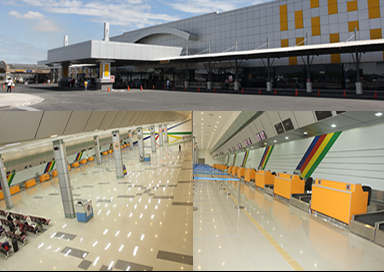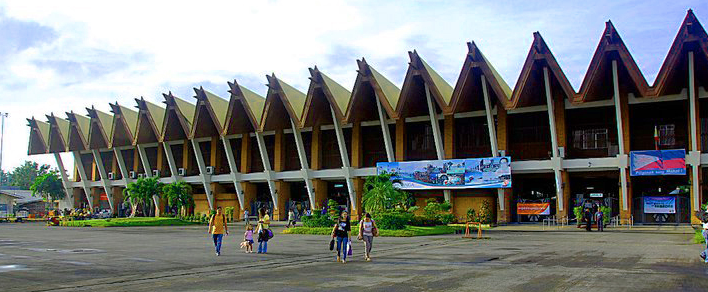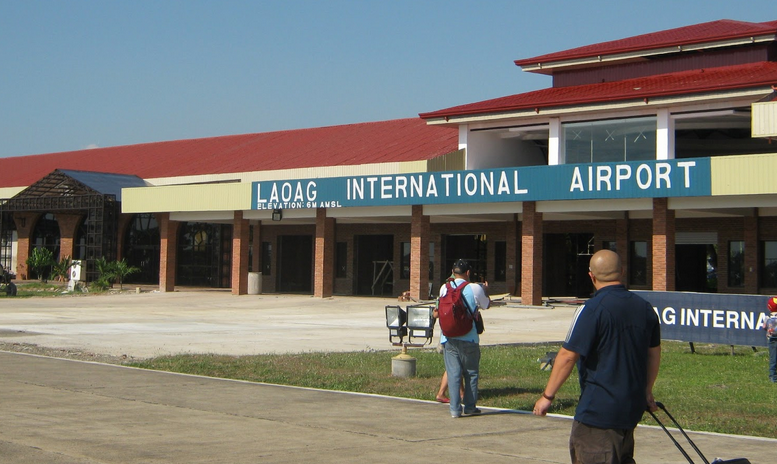Clark International Airport
Clark International Airport was called Diosdado Macapagal International Airport
Go to the web site for checking airlines schedules, flights, etc.
IATA: CRK, ICAO: RPLC), an airport that serves as an alternate international gateway to the Philippines located within the Clark Freeport Zone serving the general area of Angeles City in the Philippines, was about 43.2 NM (80.0 km; 49.7 mi)[13] northwest of Manila. The airport is surrounded by the cities of Angeles and Mabalacat; and conveniently reached by Subic-Clark-Tarlac Expressway which is linked into North Luzon Expressway.
Clark serves the general vicinity of Greater Manila Area, along with the northern regions of Luzon. It is currently a hub for Cebu Pacific and Tigerair Philippines. The airport mainly serves low-cost carriers. The name is derived from the former American Clark Air Force Base which was the largest overseas base of the United States Air Force until it was closed in 1991 and handed over to the Government of the Philippines.
History
The base was a stronghold of the combined Filipino and American forces during the end of World War II and a backbone of logistical support during the Vietnam War until 1975. Following the departure of American forces in 1991
The base was overrun by Japanese forces in early January 1942. The base then became a major center for staging Japanese air operations. Japanese aircraft flying out of Clark participated in the Battle of Leyte Gulf, considered to be the largest naval battle of the Second World War.[1][2]
During the war, the Allied prisoners of the Bataan Death March passed by the main gate of Clark Air Base, as the soldiers followed the direction of the railway tracks north, towards Camp O’Donnell. Clark Air Base was recaptured by Americans in January 1945, after three months of fierce fighting in the Philippines.
Clark grew into a major American air base during the Cold War, serving as an important logistics hub during the Vietnam War. The base was later closed due to the refusal by the Philippine government to renew the lease on the base. After extensive damage from the Mount Pinatubo eruption, the Philippine government attempted to reopen base lease talks, but terms could not be reached and the lease was not extended.
In November 1991, the United States Air Force lowered the Stars and Stripes and transferred Clark Air Base to the Philippine government. With the United States military’s withdrawal from Clark, the base was systematically looted and was left abandoned for several years. It finally became the Clark Freeport Zone, the site of Clark International Airport (CIA) and parts of it are still owned by the Philippine Air Force, retaining the same name, Clark Air Base.
In June 2012, the Philippine government, under pressure from Chinese claims to their seas, agreed to the return of American forces to Clark.
 |
|
Clark International Airport the new name for Diosdado Macapagal International Airport (DMIA), located at the heart of Central Luzon in Angeles, Pampanga, making it the more convenient airport for travellers who want to avoid the hustle and bustle of Manila’s city streets. Easily accessible by road from Subic, Metro Manila and Northern Luzon.
|
DIRECTIONS AND PARKING
The airport has a park and fly facility, only two minutes walk from the car park to the arrivals/departures area, fees from 90php per day.
Travelling from the North or South, or Subic, it is better to stay on the NLEX and SCTEX expressways, unless you know your way through Balibago from either the Angeles or Dau exit from NLEX.
On the NLEX, continue to the SCTEX towards Subic. Take the first exit, turn right, right again and right at the traffic stop lights. Turn right at the second stop light, left at the junction, at the security point turn right, the pay car park is on your left, in a few minutes you will be at the terminals.
Taking the NLEX Angeles exit you will see signs, but make sure the Marquee Mall is on your right. Follow the road to the stop lights, where you have to turn right. At the rotunda traffic Island turn left, and follow the road straight through Clark (CSEZ) to the airport.
From NLEX Dau exit, follow the road to the traffic stop light, turn left, under the big arch, at the rotunda traffic island turn right and follow the road straight through Clark (CSEZ) to the airport.
IN CLARK at the third traffic stop light turn right, next stop light turn right. At the junction turn left. Go through the security point turn right, the pay car park is on your left, a few minutes walk will take you to the terminals.
DIRECTIONS FROM NLEX, SCTEX DOWNLOAD MAP ![]()
![]()
Click the link, SAVE AS or PRINT![]()
 |
PARKING FROM only 90php PER DAY
TAXI SERVICE AVAILABLE
to Angeles, Subic, or anywhere in Luzon.
Transfers to NAIA, Manila for onward flights.
Days out and weddings.
From Wikipedia, the free encyclopedia
Terminal 1
The $3 million (PH₱130 million) current expanded Terminal 1, designed to accommodate at least one million to two million passengers annually, was inaugurated by President Arroyo on April 2008 to serve the growing passenger volume due to the entry of foreign and local budget carriers at the airport. Completed in April 2010, the $12 million (PH₱550 million) expansion added a second storey, arrival and departure lounges, and two aerobridges to the terminal building. The expansion will boost Clark’s capacity to five million from two million.[16] Once Terminal 2 is completed, Terminal 1 will take over all domestic routes.[17]
Future Development
The future international gateway for the country is currently being built at Clark International Airport. It is planned to become one of the world’s biggest in terms of terminal size and land area. A high speed railway system will be built to connect the new airport to Metro Manila. Officially, Ninoy Aquino International Airport (NAIA) is the only airport serving the Manila area. However, in practice, both NAIA and Clark International Airport(CRK) serve the Capital and surrounding cities, with CRK catering mostly to low-cost carriers that avail themselves of the lower landing fees than those charged at NAIA.
Terminal 2
The Terminal 2 of Clark comes in two phases. It will be dedicated to international traffic.[17] It has a total floor area of 35,000 square meters and a 7 million-passenger capacity per year.[22] Total investment for this phase is estimated at US$150 million (PH₱6.75 billion).[17] It includes the expansion of the eastern runway to 4000 meters.,[23] a new runway, a new cargo terminal complex, and a new control tower.[17]
Budget Terminal
On Dec. 16, 2013 it was announced that the Philippines and France are set to sign a memorandum of agreement for the plan and design of the budget terminal which is expected to be completed in the second quarter of 2016. The terminal will be designed by Aéroports de Paris and it would have a capacity of 15 million passengers per year.[19]
Terminal 3
Terminal 3 is expected to make DMIA handle 80 million passengers a year.[24] When completed, Clark Airport will have:
- 3 parallel runways
- A high-speed train.[25]
- Once completed, it can accommodate 80 million passengers annually,[21] thus becoming one of the largest airports in the world.
- Facility can accommodate the A380 once completed
Ground transportation
Motor vehicle
The Subic-Clark-Tarlac Expressway (SCTEx) provides access through the airport, with two exits: Clark North and Clark South interchange, where the latter leads directly to Clark. Passengers with connecting flights at Ninoy Aquino International Airport in Metro Manila can take North Luzon Expressway which is linked via SCTEx, then passing through Epifanio de los Santos Avenue, Roxas Boulevard and finally onto NAIA Road. The future corridor between NAIA and Clark International Airport is the Metro Manila Skyway Stage 3 from NLEx to SLEx and NAIA Expressway from Skyway and SLEx to NAIA Terminals. The target completion of the NLEx-SLEx elevated expressway link project will be on 2016.
Park and ride services are provided within the airport as well.[32]
Public transportation
Regular bus services going directly to Metro Manila are served by Partas and Philtranco; although not operating after midnight hours. By 15 January 2013, there’ll be a newly constructed lounge in TriNoma Mall that will operate 24 hours a day and will be initially offered byGenesis, Five Star, Philtranco, and Victory Liner.[33] Bus services exclusively for AirAsia and AirAsia Philippines passengers can use the free service which is operated by Victory Liner to Marquee Mall and Dau bus terminal, on certain times.[34][35]
Clark is also served by airconditioned jeepneys en route to nearby Dau bus terminal and SM City Clark. Most buses running to the northern provinces of Luzon and back to Metro Manila include a stopover at Dau bus terminal.
Zamboanga International Airport
From Wikipedia, the free encyclopedia
(IATA: ZAM, ICAO: RPMZ) is the main airport serving Zamboanga City in thePhilippines. The airport is Mindanao’s third-busiest airport after Francisco Bangoy International Airport in Davao City and Lumbia Airport in Cagayan de Oro City The airport is officially classified as an international airport by the Civil Aviation Authority of the Philippines, despite only offering scheduled domestic passenger services
The airport has one terminal and a 30,000 square-meter apron. The apron has two taxiways. The apron is capable of supporting 4 Airbus A320s and eight large general aviation planes simultaneously. There are also plans to add another apron across the old apron, so that it can accommodate many aircraft at the same time.
The terminal building has a capacity of 400 passengers. The terminal houses a metal detector and an X-ray machine, both located at the main entrance of the airport and before entering the Pre-Departure Area. The terminal also has 2 baggage carousels and push carts for passengers’ baggage. The airport has check-in counters for each of the airlines that serve Zamboanga.
Inside the terminal, there is only one store managed by the Air Transportation Office. The airport has 3 restrooms. The airport’s terminal was designed by an inspired Muslim architect. Outside the terminal are the ticketing office ofCebu Pacific, Asian Spirit and the main offices of Philippine Airlines and Air Philippines. There are also some stores and travel agencies outside the airport terminal.
Laoag International Airport
From Wikipedia, the free encyclopedia
(IATA: LAO, ICAO: RPLI) is the main airport serving the general area of Laoag City, the capital city of the province of Ilocos Norte in the Philippines. It is the only airport in Ilocos Norte and is the northernmost international airport in the Philippines by geographical location. The airport is a popular charter destination for tourists from China.
We would like to hear comments or your experience that you would like to share
Looking for a hotel try Booking.com

















